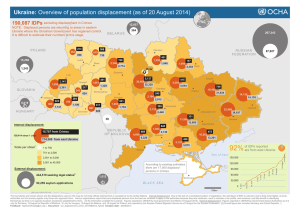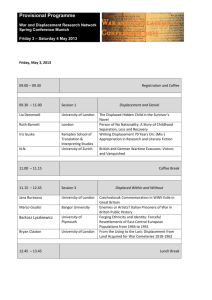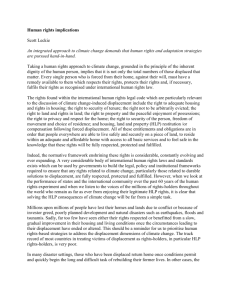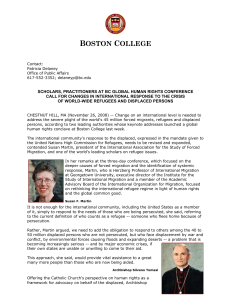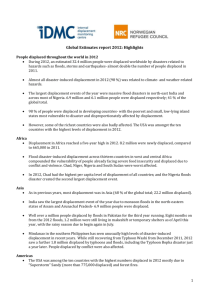Presentation by South Asia
advertisement
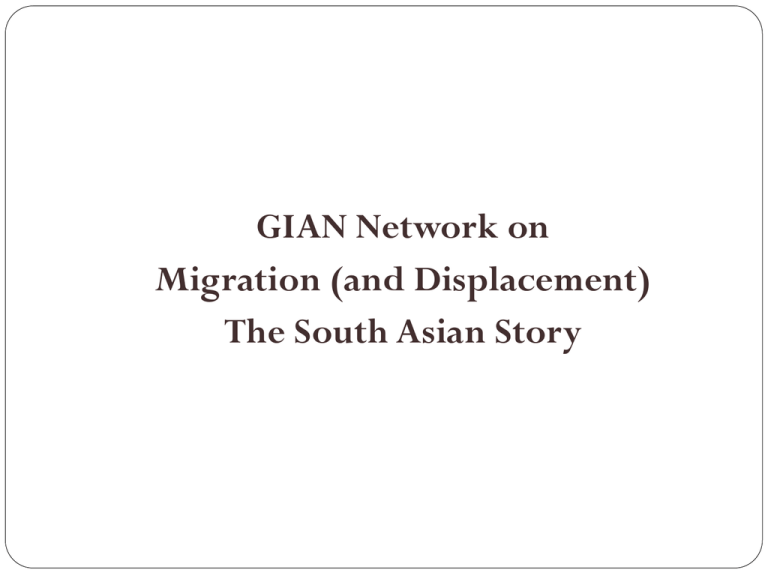
GIAN Network on Migration (and Displacement) The South Asian Story PRELIMINARY REMARKS Migration is not a major issue in India. There is not much in-migration (immigration) to India. There is out-migration (emigration)) from India to the West in search of career enhancement and job opportunities. The major issue for India is displacement caused by development projects, ethnic conflicts and natural calamities. THE BACKDROP Globalization and Economic Liberalization measures of 1990s causing impoverishment and massive social unrests. Free flow of global capital for rapid exploitation of mineral resources displaces the hapless people from their hearths and homes. According to an estimate every year 15 million people all over the globe are forcedly displaced by development projects such as dams, power plants, mines and mineral-based industries. JALA SATYAGRAHA IN MADHYA PRADESH "Till the time water level comes down to 189 meters and as per court orders, we get the 5 acre land, and labourers get Rs. 2.5 lakh, till that time even if we die, we will sit here.” IMPACT OF DISPLACEMENT (MICHAEL CERNEA) Landlessness Community Disarticulation Joblessness Homelessness Impoverishment Risks Loss of access to CPRs Increased Morbidity Marginalization Food Insecurity WHY IMPOVERISHED? 1. Landlessness has increased enormously. 2. Land Holding size decreases. Most become uneconomic. 3. Subsequent decrease in production. 4. Downward mobility of occupation: from cultivation-daily wage earners, domestic workers, petty business. 5. Niggardly Compensation: Hardly any resettlement 6. CPRs dependents suffer more EXTENT OF MIGRATION/DISPLACEMENT The Government of India does not have an official database on the number of displaced persons. According to Fernandes (2008: 89-90), there are 60 million Displaced persons during 1947-2000, from 25 million hectares (62 million acres) of land, more than half of it forest or common revenue land. Nearly 40 percent of the 60 million Displaced People and Project Affected People are tribals who are a little over 8 percent of the country’s population. 20 percent each are Dalits and the poorest among the Backwards like fisher folk and quarry workers (Murickan et al. 2003: 185-189). Migration in India (Population in thousands) Less than 100 100 to 200 200 to 300 More than 300 EXTENT OF REHABILITATION State Extent of Rehabilitation Orissa Andhra Pradesh Kerala Goa West Bengal Gujarat 35.27 % 28.82 % 13.18 % 33.23 % 9% 18 % STRENGTHS Jesuits in South Asia have centres that address the issues at the local level, national level and to some extent even at the international level. The centres are most vibrant at the local level. Example, SWADESH in Goa & NESRC in Guwahati. In the area of research, the national level centres like Indian Social Institute, Delhi and Indian Social Institute, Bangalore, have done considerable research and studies. SAPI: South Asian People’s Initiative, an offshoot of WSF 2005 of Mumbai has done commendable work in networking and advocacy. WEAKNESSES Local level protests and mobilization without linkage to national level advocacy efforts. The second lacuna has been the lack of skills in advocacy, lobbying and negotiations. The third limitation is dearth of systematic research both at the local and national level. POSSIBILITIES Working for Comprehensive Legislation Reforms in favor displaced people and project affected people. Example:The Land Acquisition and Rehabilitation and Resettlement Bill 2011 National Centres to play a proactive role in networking and advocacy efforts CONCLUSION “We have for over a century been dragged by the prosperous West behind its chariot, choked by the dust, deafened by the noise, humbled by our own helplessness, and overwhelmed by the speed. We agreed to acknowledge that this chariot-drive was progress, and that progress was civilization. If we even ventured to ask, ‘progress towards what and progress for whom’, it was considered to be peculiarly and ridiculously oriental to entertain such doubts about the absoluteness of progress. Of late, a voice has come to us bidding us to take count not only of scientific perfection of the chariot but of the depth of the ditches lying across its path”. - Rabindranath Tagore2

